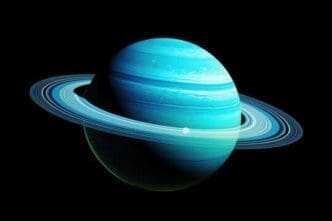Voyager 2’s flyby of Uranus in 1986 provided foundational data that shaped astronomers’ understanding of this distant planet. However, recent analysis suggests the observations made during this historic mission were influenced by an extraordinary cosmic coincidence, prompting a reevaluation of what is known about Uranus.
Voyager 2’s encounter with Uranus revealed unexpected features, such as new rings and moons, and a magnetosphere behavior that puzzled scientists. The spacecraft’s data depicted Uranus with intense electron radiation belts similar to those found around Jupiter, yet lacking an apparent plasma source to sustain this phenomenon. This contradiction led to the assumption that Uranus’ moons were geologically inactive, posing a curious anomaly among its solar counterparts.
In a twist of circumstances, Voyager 2 flew by Uranus during a rare event occurring only about 4% of the time, as emphasized by Jamie Jasinski from NASA’s Jet Propulsion Laboratory. His study indicated that just days before the flyby, a powerful solar wind hit Uranus, compressing its magnetosphere and altering its state. This resulted in the depletion of plasma and a surprising boost in the planet’s radiation belts. Had Voyager 2 arrived earlier, it might have recorded conditions more typical of other ice giants, challenging the existing perception of Uranus as an outlier.
The study published in Nature Astronomy helps explain the odd readings from Voyager 2 and suggests that some of Uranus’ moons, contrary to prior belief, might be geologically active. These moons may have been releasing ions into the magnetosphere before they were temporarily cleared out by the solar wind event.
Linda Spilker, a project scientist for the Voyager missions, noted that the magnetosphere data was merely a temporal snapshot, underscoring the need for further investigation to attain a comprehensive understanding of Uranus. This new perspective has reignited interest in sending a dedicated mission to the ice giant, as recommended by the planetary decadal survey.
Planned future explorations, including a Uranus Orbiter and Probe by NASA, aim to offer more insight into its atmosphere, rings, and moons. Meanwhile, the long-traveling Voyager 2 continues its journey into interstellar space, contributing invaluable data beyond our solar system.
The evolving understanding of Uranus underscores the need for continued exploration and study. As data from past missions like Voyager 2 undergo fresh analysis, they remind us of the dynamic nature of planetary science. With future missions poised to unlock more secrets, our knowledge of Uranus and its unique characteristics will only deepen, promising exciting discoveries ahead.
Source: Accuweather








